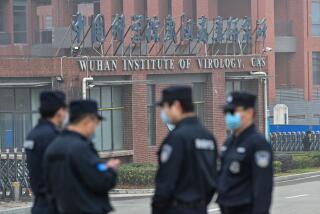4 Studies Find No Evidence of New AIDS Virus
- Share via
WASHINGTON — A puzzling flurry of cases of an AIDS-like illness that created an international sensation last summer are probably not caused by some mysterious new infectious agent but are the result of a variety of causes, according to new research released Wednesday.
The four studies, which appear in this week’s New England Journal of Medicine, are expected to put to rest the widespread fears that arose after last July’s international AIDS conference in Amsterdam that a new virus or other microbe was responsible for the AIDS-like illnesses in people who showed no evidence of HIV infection.
The mystery has been the focus of intense scrutiny by AIDS researchers, all of whom have concluded that the cases are rare and that there is no evidence of a new infectious agent at work.
Moreover, the researchers reported that the diseases probably came from multiple causes and do not represent a new kind of syndrome. They noted that such cases of mysterious immune system disease have been reported for decades but received little attention until the age of AIDS.
“It appears that we’re probably looking at many different types of diseases with a common outcome and that it is not appearing in epidemic proportions,” said Dr. David Ho, the head of the Aaron Diamond AIDS Research Center in New York City and the author of one of the studies. “And there is no convincing evidence of a new virus.”
Furthermore, the researchers said extensive virological studies showed that the unusual diseases were not caused by any strain of the human immunodeficiency virus that causes AIDS. The several dozen cases that have been studied in the United States also showed no other common links, they said.
“We looked very hard for HIV and there is absolutely no evidence of HIV in these individuals,” Ho said. “If you were looking at HIV, you would see a very consistent pattern. This does not suggest they have a common disease. The patients appear to be heterogenous--some old, some young, some with (AIDS) risk factors, some not--nothing consistent.”
Also, the studies found no evidence that spouses, sexual partners or those who had given blood to the patients were suffering from the same illnesses.
But the doctor who first told the conference about the strange batch of illnesses--Dr. Jeffrey Laurence, associate professor of medicine at the Cornell University Medical College in New York--warned Wednesday that it was premature to conclude that no new agent was responsible.
“I think it’s still an open question,” Laurence said in an interview.
He said researchers looking to solve the mystery were “casting too wide a net” and should be narrowly focusing only on individuals suffering from conditions that progress in the manner of AIDS.
“You need to bear closer scrutiny at the cases that truly look like AIDS, and these are not really the cases they are talking about,” he said.
Laurence called the New England Journal reports “an explanation and a rehash of what has already been said” at recent scientific meetings.
Researchers have named the puzzling condition “idiopathic CD4 T lymphocytopenia”--or ICL--and defined it as opportunistic infections without a known cause for the suppressed immune system.
Patients are considered to have the condition if their count of CD4 cells--which are critical to the immune system--falls below 300 two or more times with no evidence of HIV infection and no other clear reason for the low cell count. A normal count for CD4 cells, which are the primary target of HIV, is 800 or higher.
The researchers noted that until recent years CD4 levels were not routinely measured, implying that ICL would probably have not been detected as easily.
“It is highly likely that there is not a common cause for ICL,” said Dr. Anthony S. Fauci, director of the National Institute of Allergy and Infectious Diseases. “As we continue to carefully look at larger numbers of patients with immunodeficiencies, it is certainly conceivable that a rare patient will be found with an as-yet-unidentified virus that is associated with the syndrome.
“That is a far cry from saying that this group of patients here with ICL constitutes a public health problem because of a common infectious agent,” Fauci said. “The data clearly indicate that is not the case.
In addition to Ho, other researchers included scientists at the federal government’s Centers for Disease Control and Prevention, Dr. Robert A. Duncan of Boston City Hospital, Dr. Louis M. Aledort of Mt. Sinai Medical Center in New York, and Dr. Stan H. Vermund of National Institute of Allergy and Infectious Diseases.
In an accompanying editorial, Fauci chastised the media for inspiring the near-hysteria that resulted from the disclosure of the syndrome, and insisted that “the best answers to important questions about the public health come from the scientific process . . . not from a media frenzy.”






